ABOUT EIGHT YEARS ago, I bought my first real digital camera. At that time, I was regularly making frequent and intensive excursions into the wilds of Missouri and Illinois, and got the idea that I wanted to do serious nature photography.
Well, the truth is that I wanted to take serious nature photos with little actual effort, which is unrealistic. But I digress.
By 2001, digital photography had reached maturity: digital cameras had become more than just technological toys, and the prices for decent cameras had lowered to a reasonable level. Pouring over the camera reviews in Consumer Reports and photo websites, I did my research thoroughly, went to Best Buy, and bought the best camera, cost being a minor consideration, since I was enjoying the fruits of a high-paying job.
There were some problems with my camera-buying strategy. How did I know what camera I ought to get? And why did I want the ‘best’, and shouldn't I have determined what I needed instead? Although one should not be an ignorant consumer, shouldn't I have also gotten one-on-one advice from some knowledgeable person, someone who could ask me questions? Note that I was lacking in the virtue of humility and instead was puffed up in pride.
Now I had been very much into photography in my youth, but reflecting on my experience, it seems that I was more attached to gadgets than on the final results of the photographic art. The desire for the best can morally be a type of idolatry; certainly I needed far less and could have used the money saved on much worthier endeavors. This kind of behavior is widespread: see this article which describes this type of consumer mentality
But now I am giving away a bit too much of my story. Exposition, according to fiction writers, is far inferior to action. Show, don't tell. Here is the very first picture I took with my new camera:
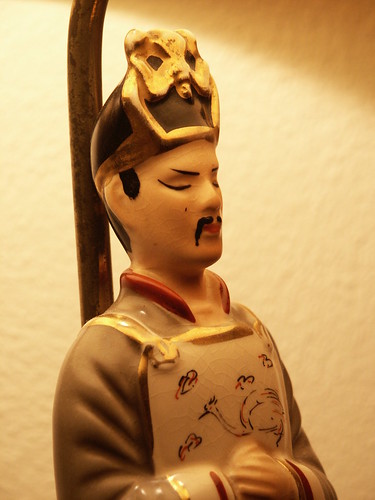
This is a detail of an antique lamp, which I got from my father's mother, and which I used to keep by my bed. Photo taken Monday, August 27th 2001, 8:45 p.m.
The color looks yellow, which probably puzzled me at the time, but photos of my aquarium, taken a few minutes later, looked nice and blue, so I didn't give it another thought. For a while.
I read the camera's manual thoroughly before even taking the first photo. I always took pride in my technical competence. But pride is perilous. Having long experience in film photography, I knew the concepts in the manual, I knew the trade-offs involved in photography, but despite my knowledge, I lacked a certain understanding, which I will get into later.
The cheap batteries which came with the camera allowed me to take only 12 photos that night before they were exhausted. From the reviews I'd read, I knew of this problem beforehand, but somehow didn't realize how frustrating this would become.
I took the camera to work the next day. At the time, I was designing and programming robots at a pharmaceutical laboratory, working in the drug discovery group. So much fun, but considering its purpose of saving lives, it was also deadly serious work.
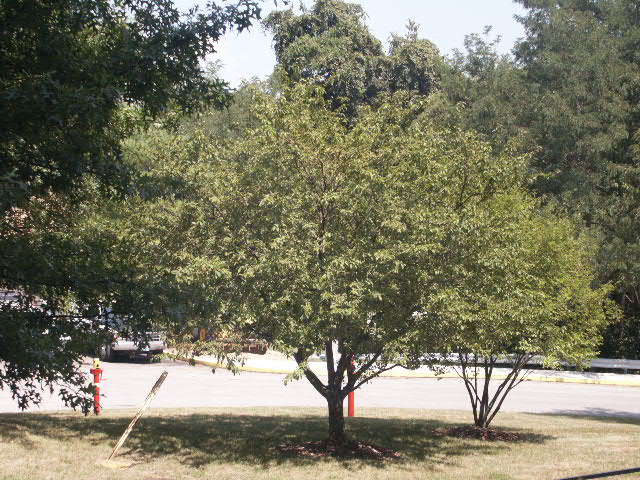
During the lunch hour, I took a series of photographs of this tree, as seen outside of my office window. The camera could take photos of various sizes, with the image data having several levels of lossy compression, and so I took photos at all available combinations of size and quality. This particular image is at the smallest size, 640 pixels across, and at lowest quality available and is a mere 1/63rd the data size of the highest quality image the camera could capture. At this size, all the photos in this series look identical.
As it happened, I did not learn the lesson I ought from this exercise. I was disappointed that I was unable to tell any difference between the photos as they appeared on my computer screen. I was disappointed rather than rejoicing in the fact that megapixels and data compression really don't mean much in ordinary photography. If you merely take straight-from-the camera photos for computer display, or if you only make normal size prints, impressive camera megapixel numbers don't really matter, and in fact can be counter-productive on some cameras due to excessive noise in an image. Also, image files can take up a large amount of space, both on the camera's memory card and in the computer, so having smaller sizes are a real benefit, especially back in those days when memory was considerably more expensive.
Now I had been very much into photography in my youth, but reflecting on my experience, it seems that I was more attached to gadgets than on the final results of the photographic art. The desire for the best can morally be a type of idolatry; certainly I needed far less and could have used the money saved on much worthier endeavors. This kind of behavior is widespread: see this article which describes this type of consumer mentality
But now I am giving away a bit too much of my story. Exposition, according to fiction writers, is far inferior to action. Show, don't tell. Here is the very first picture I took with my new camera:

This is a detail of an antique lamp, which I got from my father's mother, and which I used to keep by my bed. Photo taken Monday, August 27th 2001, 8:45 p.m.
The color looks yellow, which probably puzzled me at the time, but photos of my aquarium, taken a few minutes later, looked nice and blue, so I didn't give it another thought. For a while.
I read the camera's manual thoroughly before even taking the first photo. I always took pride in my technical competence. But pride is perilous. Having long experience in film photography, I knew the concepts in the manual, I knew the trade-offs involved in photography, but despite my knowledge, I lacked a certain understanding, which I will get into later.
The cheap batteries which came with the camera allowed me to take only 12 photos that night before they were exhausted. From the reviews I'd read, I knew of this problem beforehand, but somehow didn't realize how frustrating this would become.
I took the camera to work the next day. At the time, I was designing and programming robots at a pharmaceutical laboratory, working in the drug discovery group. So much fun, but considering its purpose of saving lives, it was also deadly serious work.

During the lunch hour, I took a series of photographs of this tree, as seen outside of my office window. The camera could take photos of various sizes, with the image data having several levels of lossy compression, and so I took photos at all available combinations of size and quality. This particular image is at the smallest size, 640 pixels across, and at lowest quality available and is a mere 1/63rd the data size of the highest quality image the camera could capture. At this size, all the photos in this series look identical.
As it happened, I did not learn the lesson I ought from this exercise. I was disappointed that I was unable to tell any difference between the photos as they appeared on my computer screen. I was disappointed rather than rejoicing in the fact that megapixels and data compression really don't mean much in ordinary photography. If you merely take straight-from-the camera photos for computer display, or if you only make normal size prints, impressive camera megapixel numbers don't really matter, and in fact can be counter-productive on some cameras due to excessive noise in an image. Also, image files can take up a large amount of space, both on the camera's memory card and in the computer, so having smaller sizes are a real benefit, especially back in those days when memory was considerably more expensive.
Good art has a certain sense of economy, by using only what is needed. While our culture often makes an idol out of efficiency, we also tend to believe that ‘bigger is better’: these two forces are set up as an Hegelian dialectic in competition with each other, which is painfully obvious in the current debates over nationalized health care. In truth these two opposite sides are both vices and therefore sinful, while virtue finds its way in moderation.
Dorothy Sayers, in her excellent book The Mind of the Maker, elaborates the same theme as did her friends J.R.R. Tolkien and C.S. Lewis: that we make by the law in which we're made. Sins against art, which we so often find these days, closely reflect the old heresies which deny one or another Person of the Holy Trinity as described in the Creeds. My artistic heresy of relying too much on camera ratings and megapixel numbers, led me to disregard my own lively response to viewing my own images. I did not see that for my purposes, the lowest quality setting on the camera was adequate.
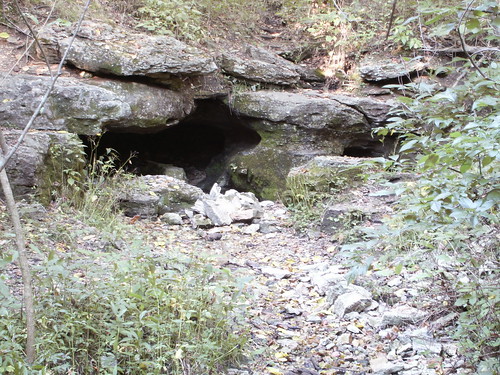
That afternoon, I went to one of my favorite spots, Babler State Park, and took a series of photos of Babler Spring. The first three photos were almost completely identical, for I had used a tripod. Now the first image was disappointing, and would have described it as being ‘washed out’; but I did not change any of the relevant camera settings on subsequent shots.
Realize that despite all my former experience with film cameras and darkroom work, I was unable to determine what was wrong with the image produced by the camera: all I knew was that it looked bad in an indeterminate way. I could see — but not interpret — what I saw. This image is overexposed, with low saturation, and with bad contrast, and all those settings could be changed in the camera, and I was certainly not naïve about the technology. I could have made a decent shot if I had true understanding.

That afternoon, I went to one of my favorite spots, Babler State Park, and took a series of photos of Babler Spring. The first three photos were almost completely identical, for I had used a tripod. Now the first image was disappointing, and would have described it as being ‘washed out’; but I did not change any of the relevant camera settings on subsequent shots.
Realize that despite all my former experience with film cameras and darkroom work, I was unable to determine what was wrong with the image produced by the camera: all I knew was that it looked bad in an indeterminate way. I could see — but not interpret — what I saw. This image is overexposed, with low saturation, and with bad contrast, and all those settings could be changed in the camera, and I was certainly not naïve about the technology. I could have made a decent shot if I had true understanding.
But even if I knew precisely how to change to camera settings to make the photos look better, I wonder now if I would have actually made the changes. Would I have told myself that it was the manufacturer's job to set the camera properly, and not mine? This is an even greater offense against art, as well as an example of exceptionally irrational and sinful pride.
I had a belief that digital technology had put an end to all the mess that we had to deal with in film photography, including most of what was done in the darkroom. Particularly, I was naïve enough to think that the camera's automatic settings were adequate, even though I knew that not to be the case with film cameras. Although I did not know it at the time, film, especially black and white film, is far more forgiving of exposure errors than is digital, so it is more likely that a digital camera's automatic settings are less adequate.
I did not study the art of digital photography as I ought. Rather, I made the error of believing that I would find satisfaction through a single act of the will: making the right purchase. As many now think that salvation can be found by a single conversion experience — instead of a continuous pursuit of the virtues — contemporary consumer culture elaborates on this error by emphasizing purchase over use.
Recall that I specifically purchased this camera to take serious nature photos, especially wildflowers. About 20 minutes, four photos, and one battery change after that last shot, I took a single photo of a wildflower as a test:

Very disappointing, and again I ought to have known how to correct the problem and get a good image; rather it just appeared washed out to my eye. I took perhaps four additional wildflower photos over the next several years. So much for my fantasies of doing nature photography.
But what killed my serious interest in digital photography for the next four years was this photo, taken about an hour or so later:

As it was sunset, this likely was a gorgeous scene in real life, but the camera image was hugely disappointing: white skies, murky shadows, little color. It was hardly what I remembered seeing.
What should it have looked like? Try this image, taken seven years later from the same spot on the old Route 66 bridge in Times Beach over the Meramec River:
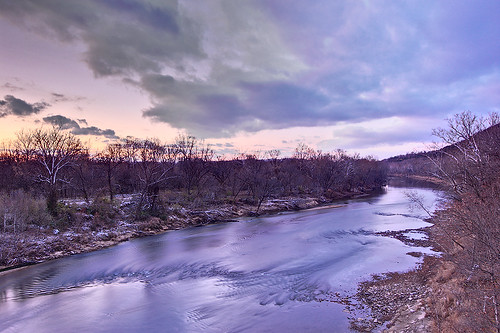
Not a perfect photo, but certainly closer to what I remembered seeing.
The next day I took a few photos of my aquarium, as well as a self-portrait that I emailed to a lady friend, and the camera rested for two days.
On September 1st, 2001, I went to the old Saint Stanislaus Jesuit seminary in Florissant, Missouri, with a Catholic buddy. I was not yet Catholic at that time, my confirmation being nearly two years in the future. Although I had been convinced of the truth of the Faith, I felt uncomfortable about joining a Church full of sinners, while still wanting to be a sinner myself. Ironic, yes?

The very first photo I took that day was of the chapel. At the time, I had no idea that taking church photos would become my advocation, or as some say, my apostolate. I just wanted to take nature photos, and those nature photos were miserable failures.
September 1st, 2001 — just ten days later the world changed. But this day was a happy day, and my biggest worry was over a camera I put too much hope in, and spent too much money on.
We were visiting here that day so my buddy could meet a college professor, from whom he took numerous courses.
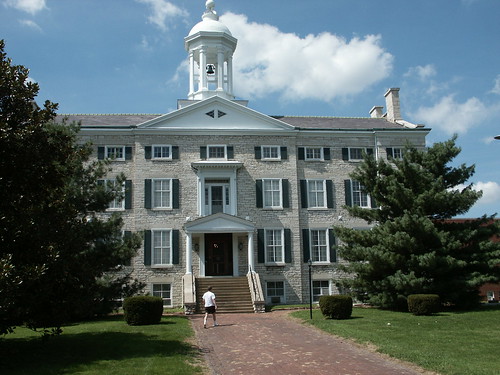
Inside this building was Fr. William Barnaby Faherty, S.J., professor emeritus of history at SLU, and prolific author, who was signing copies of his latest books. Never did I dream that the next time I would meet Fr. Faherty we would be discussing our collaboration on a photo book of Saint Louis area Catholic churches.
This is the Old Rock Building, which at the time housed a museum of the western Jesuit missions, and now is apparently abandoned.

After nearly two hours of exploring the marvelous collection of artifacts in the museum — which are now housed at the Saint Louis University campus — I took this photo. Note that the sky is completely washed out, and the shadows murky. I had failed to take any photos inside the museum, for reasons that aren't clear to me now.
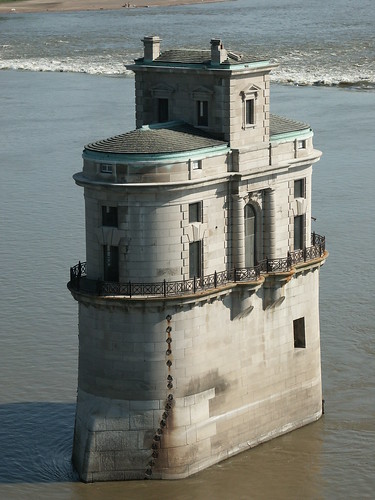
Less than an hour later we were on the old Chain of Rocks bridge, which is reserved to pedestrians and bicycles. This is an old water intake tower, done in the marvelous Victorian fashion, and this was the camera's first photo that I really liked. Now I can see that the exposure is practically perfect, and the colors, although somewhat muted, look fine.
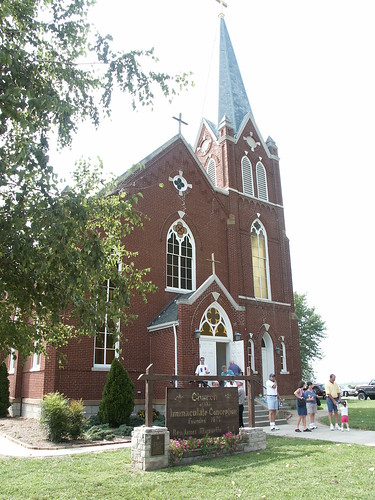
The next day we visited Kaskaskia, Illinois and environs. This is a photo of Immaculate Conception Church, which that day was holding its 328th (!!!) annual festival. But there is way too much wrong with this photo: the sky is white and the spire looks like it is sagging over. I could have avoided the first problem by overriding the automatic exposure a bit: I knew how to do that, but didn't, even though nearly all of my photos were coming out overexposed — my own psychology can be quite maddening at times. (Nowadays, when walking around taking casual snapshots, I typically override my camera's automatic setting by minus ⅔ of an f/stop.) The second problem would have been solved by stepping back a distance and zooming in a bit.
Amusingly, I came to the conclusion that my poor photographic results were due to the camera being bad. Perhaps the standard camera settings were inadequate for someone like me at the time — a purely casual user who had no desire to adjust the settings depending on the situation. But I ought to have known better, and my poor results were due to sheer laziness.
Pure consumer-grade cameras will often juice up the final images to look better, since the manufacturers know that these consumers will only make small prints, and certainly won't be doing any post-processing on the computer. But this strong in-camera processing means that the images provided won't be suitable for later manipulation in Photoshop. So in fact, a commercial-grade camera will normally produce photos that are relatively soft, flat, and somewhat unsaturated, since they assume the user will be doing some custom post-processing later, or at the very least change the camera's internal settings appropriately.
The muted colors were in part due to the camera's native (and non-standard) wide color gamut, which allowed it to capture a wider range of colors (particularly green colors) than is found in the sRGB standard used on the web and on virtually all current cameras. When such an image is displayed on the computer, in the absence of special software, it will appear muted in color, although this seems counter-intuitive. Most critically for me, the saturation in green colors found in nature was particularly muted.
The manufacturer specified that all images ought to be processed on the computer via their supplied software, which made the photos look more saturated, but due to a flaw, they also appeared far too dark. Certainly the manufacturer should have included a mode in the camera which would use the standard color gamut, and ought to have made that the standard setting, with the wide-gamut feature being an option that could be set if needed. But instead of criticizing the manufacturer, perhaps I ought to have questioned my choice in the original purchase.
The flaw, I think, in the Consumer Reports worldview is that it turns consuming into a somewhat passive activity while simultaneously giving the consumer the feeling that he is wise about his purchases. This worldview sets up an opposition between the producers and consumers of technology, and can lead to a certain childishness among consumers, who may end up becoming rather demanding with the producers of technology, while retaining a foolish passivity during its use, as my experience here painfully shows. Producing camera technology is a kind of art, but so is taking pictures, so the opposition above is false: everyone needs to have the virtue of an artist, and not just they who make technology. Obviously manufacturers ought to be generous to consumers, by making products that are safe, reliable, and workable, but consumers also have a responsibility to use the technology properly. Contemporary consumer protection laws assume this kind of childishness by imposing strict liability on producers.

Very disappointing, and again I ought to have known how to correct the problem and get a good image; rather it just appeared washed out to my eye. I took perhaps four additional wildflower photos over the next several years. So much for my fantasies of doing nature photography.
But what killed my serious interest in digital photography for the next four years was this photo, taken about an hour or so later:

As it was sunset, this likely was a gorgeous scene in real life, but the camera image was hugely disappointing: white skies, murky shadows, little color. It was hardly what I remembered seeing.
What should it have looked like? Try this image, taken seven years later from the same spot on the old Route 66 bridge in Times Beach over the Meramec River:

Not a perfect photo, but certainly closer to what I remembered seeing.
The next day I took a few photos of my aquarium, as well as a self-portrait that I emailed to a lady friend, and the camera rested for two days.
On September 1st, 2001, I went to the old Saint Stanislaus Jesuit seminary in Florissant, Missouri, with a Catholic buddy. I was not yet Catholic at that time, my confirmation being nearly two years in the future. Although I had been convinced of the truth of the Faith, I felt uncomfortable about joining a Church full of sinners, while still wanting to be a sinner myself. Ironic, yes?

The very first photo I took that day was of the chapel. At the time, I had no idea that taking church photos would become my advocation, or as some say, my apostolate. I just wanted to take nature photos, and those nature photos were miserable failures.
September 1st, 2001 — just ten days later the world changed. But this day was a happy day, and my biggest worry was over a camera I put too much hope in, and spent too much money on.
We were visiting here that day so my buddy could meet a college professor, from whom he took numerous courses.

Inside this building was Fr. William Barnaby Faherty, S.J., professor emeritus of history at SLU, and prolific author, who was signing copies of his latest books. Never did I dream that the next time I would meet Fr. Faherty we would be discussing our collaboration on a photo book of Saint Louis area Catholic churches.
This is the Old Rock Building, which at the time housed a museum of the western Jesuit missions, and now is apparently abandoned.

After nearly two hours of exploring the marvelous collection of artifacts in the museum — which are now housed at the Saint Louis University campus — I took this photo. Note that the sky is completely washed out, and the shadows murky. I had failed to take any photos inside the museum, for reasons that aren't clear to me now.

Less than an hour later we were on the old Chain of Rocks bridge, which is reserved to pedestrians and bicycles. This is an old water intake tower, done in the marvelous Victorian fashion, and this was the camera's first photo that I really liked. Now I can see that the exposure is practically perfect, and the colors, although somewhat muted, look fine.

The next day we visited Kaskaskia, Illinois and environs. This is a photo of Immaculate Conception Church, which that day was holding its 328th (!!!) annual festival. But there is way too much wrong with this photo: the sky is white and the spire looks like it is sagging over. I could have avoided the first problem by overriding the automatic exposure a bit: I knew how to do that, but didn't, even though nearly all of my photos were coming out overexposed — my own psychology can be quite maddening at times. (Nowadays, when walking around taking casual snapshots, I typically override my camera's automatic setting by minus ⅔ of an f/stop.) The second problem would have been solved by stepping back a distance and zooming in a bit.
Amusingly, I came to the conclusion that my poor photographic results were due to the camera being bad. Perhaps the standard camera settings were inadequate for someone like me at the time — a purely casual user who had no desire to adjust the settings depending on the situation. But I ought to have known better, and my poor results were due to sheer laziness.
Pure consumer-grade cameras will often juice up the final images to look better, since the manufacturers know that these consumers will only make small prints, and certainly won't be doing any post-processing on the computer. But this strong in-camera processing means that the images provided won't be suitable for later manipulation in Photoshop. So in fact, a commercial-grade camera will normally produce photos that are relatively soft, flat, and somewhat unsaturated, since they assume the user will be doing some custom post-processing later, or at the very least change the camera's internal settings appropriately.
The muted colors were in part due to the camera's native (and non-standard) wide color gamut, which allowed it to capture a wider range of colors (particularly green colors) than is found in the sRGB standard used on the web and on virtually all current cameras. When such an image is displayed on the computer, in the absence of special software, it will appear muted in color, although this seems counter-intuitive. Most critically for me, the saturation in green colors found in nature was particularly muted.
The manufacturer specified that all images ought to be processed on the computer via their supplied software, which made the photos look more saturated, but due to a flaw, they also appeared far too dark. Certainly the manufacturer should have included a mode in the camera which would use the standard color gamut, and ought to have made that the standard setting, with the wide-gamut feature being an option that could be set if needed. But instead of criticizing the manufacturer, perhaps I ought to have questioned my choice in the original purchase.
The flaw, I think, in the Consumer Reports worldview is that it turns consuming into a somewhat passive activity while simultaneously giving the consumer the feeling that he is wise about his purchases. This worldview sets up an opposition between the producers and consumers of technology, and can lead to a certain childishness among consumers, who may end up becoming rather demanding with the producers of technology, while retaining a foolish passivity during its use, as my experience here painfully shows. Producing camera technology is a kind of art, but so is taking pictures, so the opposition above is false: everyone needs to have the virtue of an artist, and not just they who make technology. Obviously manufacturers ought to be generous to consumers, by making products that are safe, reliable, and workable, but consumers also have a responsibility to use the technology properly. Contemporary consumer protection laws assume this kind of childishness by imposing strict liability on producers.
And the very persons who are most likely to fall into this trap are those who think themselves wise. A humble person would not make the mistakes that I made. Imagine instead, a somewhat snooty camera salesman of a bygone era, looking down his nose at me and saying “Oh, I am so sorry, but we only sell this camera to professionals,” forcing humility upon me. This is hardly an egalitarian attitude, nor does it encourage consumer empowerment, but it is practical. This kind of salesman knows that it is highly likely that the purchaser will be disappointed, for he can quickly determine that the buyer really isn't interested in the art of photography, but rather wants to purchase an idol made of glass and metal.
As I found out later, a person has to actively and constantly cooperate with graces received in order to benefit from such graces. The modern notion that you can merely passively reap the fruits of graces has led to so many problems in our world today. And it reinforces the notion of consumption described here: I failed to cooperate with the technology of my camera, expecting photographic salvation via my single act of purchase.
Another error, similar to the one I exhibit here, would be the attitude that these photos are the best, because the camera is the best. Anyone pointing out these obvious photographic flaws to this kind of consumer would find himself attacked: obviously you don't know good photography when you see it. This case is like the parable of the emperor who had no clothes.
The tumultuous events of September 11th, 2001 meant that I put the camera away until late October. By this time, I was unable to return the camera to the store for a refund, so I was stuck with it.
Walker Percy noted that times of horrific violence, like the attacks of September 11th, will often bring people to back to reality. Suddenly, our relationships with each other, the cosmos, God, and ourselves come back into sharp focus. Psychologically, modern man is like a disembodied spirit, with a false sense of autonomy, who is “lost in the cosmos” (which is the title of Percy's book on the subject), and so many of us have lost the sense of these real relationships. The main problem, according to Percy, is that when times of crisis are over, people will quickly revert to their ‘disembodied’ state, while perversely looking forward to the next crisis to make them feel real again.
In retrospect, I can see now that I was one of Percy's disembodied spirits, wandering the cosmos, with poorly defined relationships. The terror attacks certainly changed everything in my life, as it did in the world at large. Decency and respect suddenly reappeared, and true charity was found everywhere. Sadly, nowadays things are mostly back to our ‘normal’ sinful state.
Were I still interested in photography, perhaps I would then have taken a more realistic approach to using the camera. But there were more important things happening in the world and in my life.

This is a photo taken atop the sandstone bluffs above Pacific, Missouri, at sunset. October 27th, 2001, 5:55 p.m.
This did not capture my impression of the scene.

Here is the same photo, corrected in Photoshop. The public generally thinks of Photoshop as a tool to generate digital image forgeries, and it can be used to do that, but it also can be legitimately used to correct defects in images. For example, the camera's automatic white balance subtracted out the color of the sunset by shifting yellow to blue, and magenta to green: we can see this in the top image by the color of the white buildings which are distinctly blue. This is corrected in the bottom photo, which gives a more natural impression of the scene.
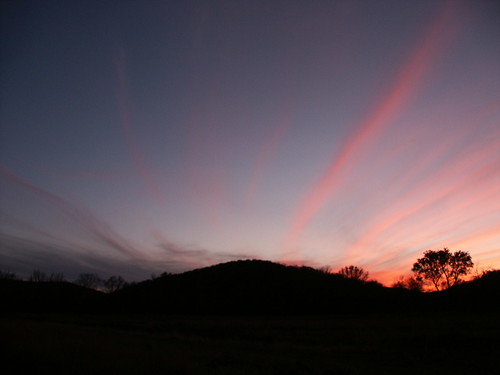
Original photo.
November 3rd, 2001, 6:11 p.m. Sunset at Forest 44 Conservation Area. This is a delightful area near Valley Park, with a number of springs as well as creek-draining crevice. Note how much additional detail was present, but not visible, in the original photo's shadows. However, highlights in digital photography have a hard cut-off and cannot be recovered. A general rule of thumb for digital is expose to preserve the highlights, and post-process to enhance the shadows. This is the opposite of the rule used with film negatives.
Over the next several years, I took few photos, with many being pictures of nature and friends and family. Very few of the photos I took in 2002 and 2003 have the combination of being both technically good and of general interest.
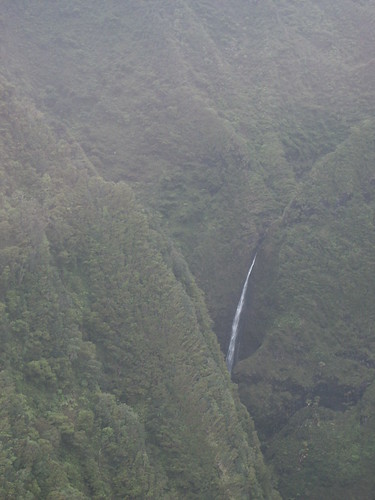
Sacred Falls, on the island of Oahu, Hawaii. February 16th, 2002, 4:07 p.m. This is a better photo that it appears, and could be greatly improved with an increase in saturation and contrast.
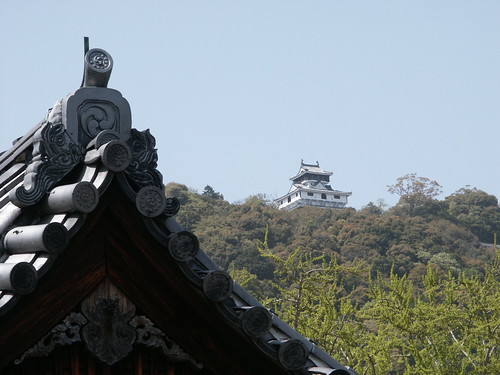
A reconstructed medieval castle, in Japan. April 12th, 2002, 6:41 p.m. I really liked this particular image. My photos of that era still were still largely overexposed, but this one was fine. The shadow under the eaves of the left building has plenty of brown wood detail that could be brought out with Photoshop. Typically, obvious shadow detail in real life is portrayed rather darkly in digital photos.
A major problem with digital cameras is that they don't model human vision very well. A neutral gray color — one that looks, to the eye, as being halfway between pure black and pure white — is actually only about 13% or 18% as bright as pure white. We are very visually sensitive to what goes on in the shadows, and less so for bright areas. We also can see details over a very wide range of brightness in one scene. Cameras however are equally sensitive to all levels of brightness within a very narrow range.
Photographic brightness is measured in units called Exposure Value, or E.V., with each unit equal to a doubling of measured brightness. Cameras can typically record of range of brightness of about 11 E.V., and just under 14 E.V. for the most sensitive (and expensive) cameras. I recently took a photo of a stained glass window at the Belleville cathedral - I could simultaneously see detail in the darkest shadow on the wall as well as the brightest pane in the window, with a range of brightness I estimate to be about 18 E.V. No digital camera could record this range of tones in one shot: either the highlights will be pure white, or the shadows pure black (or random colored noise), or likely both.
My current camera, like most, has a maximum dynamic range of 11 E.V. If a camera were to render a medium gray tone accurately, that would leave us with only 2.5 to 3 E.V. headroom to record any brighter colors, while 8 to 8.5 E.V. is in the shadows. Hence digital cameras usually overexpose the highlights of an image, yet retain dark shadows with invisible detail.
You can custom process the image on the computer to make it look more realistic, or one-size-fits-all processing can be done in the camera itself. Some cameras even include algorithms that roughly approximate the visual impression the human eye would have when viewing the scene; but there still remain severe technological limits.

This is a Catholic church in Japan. April 16th, 2002, 5:00 p.m. At that time, I was engaged to a nice Catholic girl, and we were to be married in a proper Catholic ceremony. I was not yet Catholic myself: I'd get around to it eventually, I told myself.
For the remainder of the year, I took only 45 photos, mainly of nature and family, and none are of much general interest, nor did I care to improve my photography skills. Also by the end of the year I was out of a job, out of an engagement, and into a catechetical program to enter the Church.
I was received into Holy Mother Church on Trinity Sunday of 2003. Of the 98 photos I took that year, these two are of some interest:

I went to Chicago, Illinois, to see an exhibition of large sailing craft. This particular photo was exposed well, unlike most of the rest, and I increased the saturation on the computer. August 2nd, 2003, 5:27 p.m.
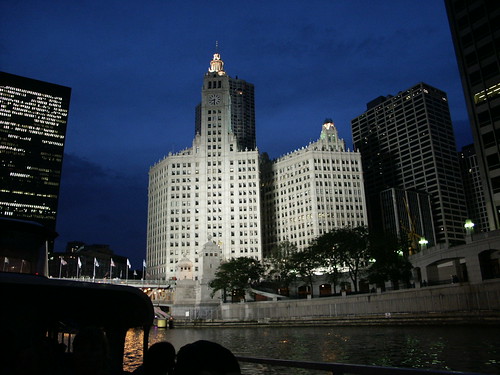
Same day, 8:31 p.m., on a boat tour along the Chicago River.
I would have liked to be able to claim that becoming Catholic improved my photography, and though it may have, this occurred much later, and only when I started taking photos for the benefit of others, and not just my own personal pleasure.
In the meantime, I was attempting to deepen my prayer life and to live a life of virtue, things that may God renew in me with new fervor!
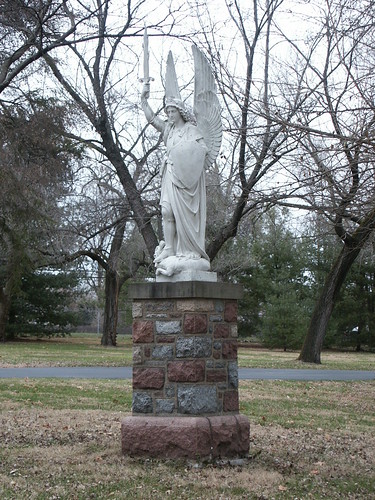
Saint Michael the Archangel, defend us in battle.
January 1st, 2004, 4:46 p.m., Discalced Carmelite Monastery, in Ladue, Missouri. This was my first church-related photo since my entry into the Church.
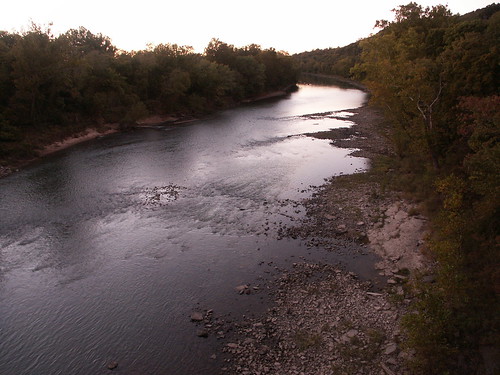
October 2nd, 2004, 6:52 p.m. A photo from the same spot on the bridge over the Meramec River, and I obviously hadn't learned anything after three years.

The tower of the new Mission San Rafael church, in California. November 5th, 2004, 3:36 p.m. I was living in California for business, and took only a few photos of the local mission churches. Having a relatively small hard disk drive on my laptop computer, I was quite sparing in taking photos, even though I already demonstrated that I could have used high image compression with little negative effect.
At this time, I was becoming aware of the liturgical renewal in the Church: eventually my photography was specifically inspired by this renewal.
Less than a month later, I started Rome of the West. My interest in photography was picking up, and eventually in March of 2005 I purchased a ‘good’ (and inexpensive) camera that produced attractive-looking photos straight out of the camera. I wanted to post photos to my blog, but didn't know how.

My first blog photo, June 3rd, 2005, 4:14 p.m., and posted that day. Saint Francis de Sales Church, in Saint Louis, Missouri. At the time I wrote:
Starting in July, this will be the new home of the Institute of Christ the King Sovereign Priest in Saint Louis. It will be known as Saint Francis de Sales Oratory. It is beautiful and ornate in the interior.Shortly thereafter, a correspondent asked if I had any photos of churches that were to be closed. This was the turning point. I went around, taking a number of poor-quality photos of the various churches, and posted them by the end of the month.
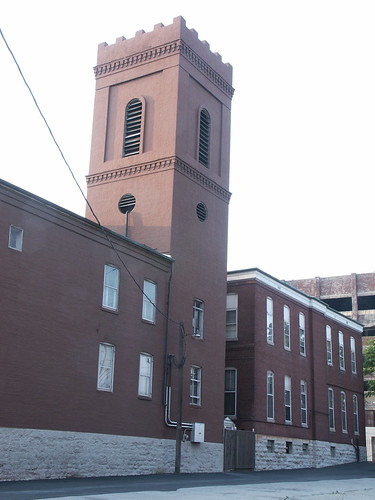
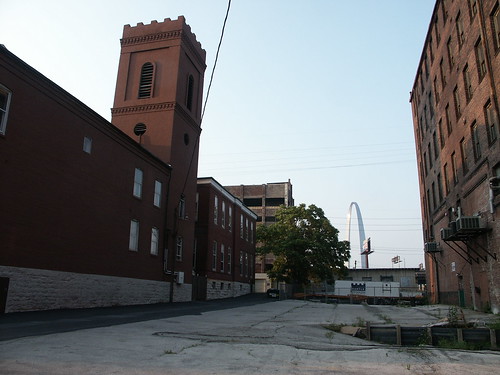
June 23rd, 2005, both taken at 7:16 p.m. Saint Mary of Victories Church, in Saint Louis. (This church did not close, but became a chapel.) It was one of these photos that changed my attitude towards photography. For the first time since going digital, I tried to look at my own photos through someone else's eyes. No longer was I taking photos for my own personal reasons; and since they were of sacred art, and for the public, poor quality was no longer acceptable.
Why were these photos poor? And what must I do to take better photos in the future? I never asked these questions before. And for the first time, I actually studied the art of digital photography.



No comments:
Post a Comment